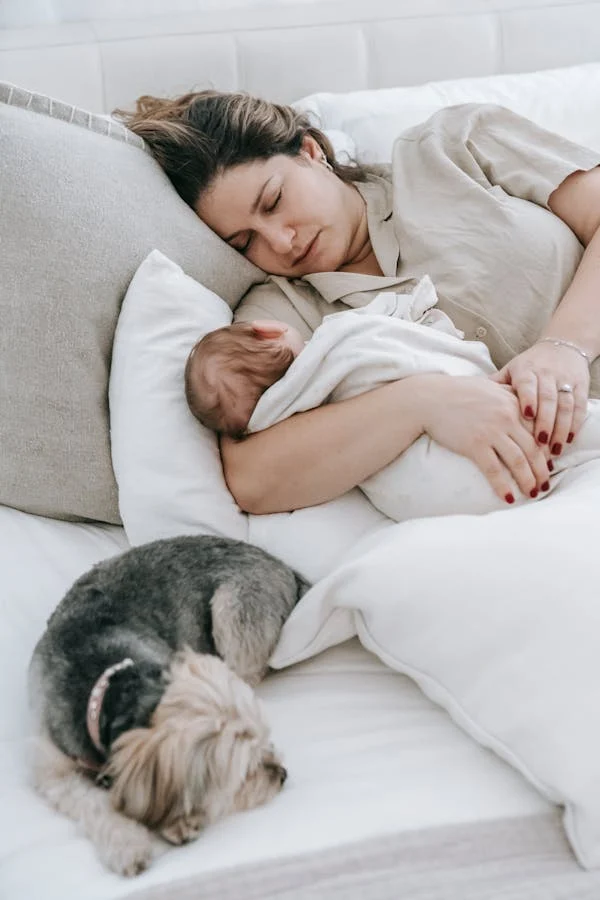Welcoming a new baby or pet into your home is an exciting time, but it can also be a source of stress and anxiety for your existing dog. Ensuring a smooth transition requires careful preparation, patience, and understanding. Whether you’re bringing a baby or a new furry friend into the household, this guide will provide you with detailed steps to help your dog adjust and ensure a harmonious environment for all family members.
1. Preparing Your Dog for a New Baby
1.1 Start with Basic Training and Behavior Adjustment
1.1.1 Reinforce Basic Commands
- Training Focus: Ensure your dog is well-versed in basic commands like “sit,” “stay,” “come,” and “leave it.” These commands will help you manage their behavior effectively.
- Consistency: Use consistent commands and positive reinforcement to strengthen their obedience.
1.1.2 Address Behavioral Issues
- Identify Problems: Address any existing behavioral issues such as jumping, barking, or aggression before the baby arrives.
- Seek Professional Help: Consult a professional dog trainer or behaviorist if necessary to resolve more serious issues.
1.2 Gradual Introduction to Baby Sounds and Smells
1.2.1 Exposure to Baby Noises
- Play Recordings: Play recordings of baby sounds (crying, cooing) at a low volume and gradually increase the volume as your dog becomes accustomed to the noises.
- Positive Association: Pair the sounds with treats and praise to create positive associations.
1.2.2 Introduce Baby Scents
- Use Baby Lotion: Rub a small amount of baby lotion or powder on your hands and let your dog sniff it to get used to new scents.
- Baby Items: Allow your dog to explore baby items like blankets and toys to familiarize them with the new smells.
1.3 Prepare Your Dog’s Space
1.3.1 Create a Safe Haven
- Designate Space: Set up a specific area where your dog can retreat to when they need a break from the commotion. This can be a bed, crate, or a quiet room.
- Comfort Items: Ensure this space includes their favorite toys and comfort items.
1.3.2 Adjust Routine
- Consistency: Maintain your dog’s routine as much as possible to provide stability during the transition.
- Gradual Changes: If you need to alter their schedule, do so gradually to help them adjust.
1.4 Introduce the Baby Gradually
1.4.1 First Meeting
- Controlled Introduction: Introduce your dog to the baby in a controlled and calm manner. Keep the dog on a leash if necessary and ensure that the baby is secure.
- Positive Reinforcement: Reward your dog with treats and praise for calm behavior during the introduction.
1.4.2 Supervised Interactions
- Always Supervise: Never leave your dog alone with the baby, even if they seem to be getting along well.
- Monitor Body Language: Watch for any signs of stress or discomfort in your dog and address them promptly.
1.5 Educate Family Members
1.5.1 Involve Everyone
- Family Training: Ensure that all family members are aware of the new routines and how to interact with the dog and baby safely.
- Consistency: Maintain consistent rules and routines to help your dog adjust.
2. Preparing Your Dog for a New Pet
2.1 Evaluate Your Dog’s Temperament
2.1.1 Assess Behavior
- Current Behavior: Evaluate how your dog interacts with other animals. If they show signs of aggression or fear, you may need to address these issues before introducing a new pet.
- Behavioral History: Consider any past experiences your dog has had with other pets to gauge how they might react to a new addition.
2.1.2 Prepare for Change
- Gradual Introduction: Prepare your dog for the new pet by gradually introducing them to the idea of another animal in the home.
2.2 Prepare for the New Pet’s Arrival
2.2.1 Set Up Separate Spaces
- Initial Separation: Prepare separate spaces for the new pet and your dog initially to allow them to acclimate without direct interaction.
- Comfort Items: Ensure each pet has their own bed, toys, and food and water bowls.
2.2.2 Introduce New Pet’s Scent
- Scent Familiarization: Before the new pet arrives, introduce your dog to the new pet’s scent by swapping bedding or toys between them.
2.3 Gradual Introduction Process
2.3.1 Initial Meeting
- Controlled Introduction: Introduce the new pet and your dog in a neutral area, such as outside or a different room. Use leashes or crates if needed to maintain control.
- Positive Reinforcement: Reward both pets for calm behavior during the introduction.
2.3.2 Monitor Interactions
- Supervised Play: Allow them to interact under supervision, gradually increasing their time together as they become more comfortable.
- Observe Behavior: Watch for signs of aggression or stress and address any issues immediately.
2.4 Maintain Routine and Provide Attention
2.4.1 Keep Routines Consistent
- Daily Schedule: Maintain your dog’s routine as much as possible to provide a sense of stability amidst the changes.
- Equal Attention: Ensure you provide equal attention to both pets to prevent jealousy or behavioral issues.
2.4.2 Gradual Adjustment
- Patience: Be patient as your dog and new pet adjust to each other. Allow them time to build a positive relationship.
- Training: Consider additional training for both pets to foster good behavior and smooth interactions.
3. General Tips for a Smooth Transition
3.1 Establish Clear Rules and Boundaries
3.1.1 Consistent Training
- Reinforce Commands: Continue reinforcing basic commands and training to help manage your dog’s behavior during the transition.
- Clear Boundaries: Set clear boundaries and rules for interactions between your dog, the baby, or the new pet.
3.2 Provide Mental and Physical Stimulation
3.2.1 Enrichment Activities
- Interactive Toys: Use interactive toys and enrichment activities to keep your dog mentally and physically stimulated.
- Exercise: Ensure your dog gets regular exercise to help manage any stress or anxiety related to the changes.
3.3 Seek Professional Guidance
3.3.1 Consult Experts
- Veterinarian Advice: Consult your veterinarian for advice on managing your dog’s health and behavior during the transition.
- Professional Trainer: Seek the help of a professional dog trainer or behaviorist if you encounter any significant issues.
Conclusion
Preparing your dog for the arrival of a new baby or new pet requires careful planning, patience, and understanding. By following these detailed steps, you can help ensure a smooth transition and create a harmonious environment for all family members. Remember to maintain consistent routines, provide positive reinforcement, and seek professional guidance if needed. With thoughtful preparation and a proactive approach, you can foster a loving and balanced home for both your dog and the new addition to your family.











Leave a Reply